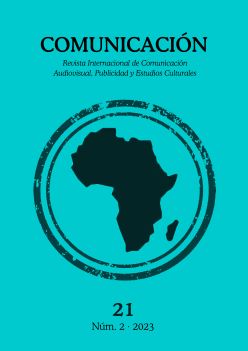Abstract
Este artículo estudia la génesis del cine de Sembene Ousmane durante los primeros años de la independencia de Senegal. Sembene fue un destacado escritor senegalés anticolonialista que se pasó al cine durante el “interludio de las independencias”, de 1960 a 1965, con su primera película Borom Sarret (1963, lo que le convirtió en pionero del cine africano. Su revolucionaria cinematografía y su proyecto artístico radical lo catapultaron al panteón de la cinematografía mundial. Basándonos en la crítica cinematográfica poscolonial, este artículo se centra en sus dos primeras películas: Borom Sarret y Niaye (1964). El argumento principal es que Sembene realizó estratégicamente estas películas para contribuir de forma genuina al esfuerzo colectivo de la reconstrucción nacional, poniendo énfasis en la relación de género. El artículo comienza con un breve repaso de las obras literarias que Sembene publicó durante el periodo estudiado, con especial enfoque en la masculinidad, para comprender mejor las dinámicas de poder y su impacto desde una perspectiva artística. A continuación, profundiza en el análisis del legado colonial y ancestral en Borom Sarret y, por último, se centra en Niaye para explorar la representación de la memoria colectiva y las dinámicas patriarcales en una sociedad seudofeudal en transición del colonialismo a la independencia, por un lado, y de la tradición a la modernidad, por el otro. Este artículo contribuye a una mejor comprensión de cómo Sembene abordó la transformación social, navegó por las estructuras del poder (pos)colonial conformadas por legados coloniales y ancestrales, y se estableció
como artista iconoclasta.
References
Andrade-Watkins, C. (1993). Film production in Francophone Africa 1961 to 1977: Ousmane Sembène – An Exception. In S. Gadjigo et al. (Eds.), Ousmane Sembène, Dialogues with Critics and Writers (pp. 29-38). University of Massachusetts Press.
Bâ, A. H. (1976). En Afrique cet art où la main écoute. Le courrier.
Bensmaïa, R. (2007). A cinema of Cruelty. In J. Rouch & J. Ten Brink (Eds.), Building Bridges (pp. 73-85). Wallflower.
Bidima, J.-G. (2002). Introduction. De la Traversée : Raconter des Expériences, Partager le Sens.
Collège international de Philosophie, 2(36), 7-18.
Blanchard, P. & Korn-Brzoza, D. (2020). Décolonisations, du sang et des larmes (2 × 80 min). France.
Bouchard, V. (2012). Pour un Cinéma Léger et Synchrome. Invention d’un dispositif à L’office du film à Montréal. Presses Universitaires de Septentrion.
Busch, A. & Annas, M. (Eds.). (2008). Ousmane Sembène: Interviews. University Press of Mississippi.
Case, F. I. (1993). Aesthetics, Ideology, and Social Commitment in the Prose Fiction of Ousmane Sembène. In S. Gadjigo et al. (Eds.), Ousmane Sembène, Dialogues with Critics and Writers (pp. 3-13). University of Massachusetts Press.
Cham, M. (2008). Official History, Popular Memory: Reconfiguration of the African Past in the Films of Ousmane Sembene. Contributions in Black Studies, 11(4).
Connell, R. & Messerschmidt, J. W. (2005). Hegemonic Masculinity: Rethinking the Concept. Gender and Society, 19(6), 829-859.
Connell, R. (2016). Masculinities in Global Perspective: Hegemony, Contestation, and Changing Structures of Power. Theory and Society, 45(4), 303-318.
Crettien, C. (1985). France’s Relations with Her Former Colonies. Proceedings of the Meeting of the French Colonial Historical Society, 8, 1-8.
De Groof, M. (2010). Black Film Label. Negritude and Camera. Third Text, 24(2), 249-262.
Diagne, I. (2014). Lire et relire Sembene Ousmane. Harmattan.
Diagne, S. B. (2001). Africanité et écriture en Français.
Diawara, M. (1988). Popular Culture and Oral Traditions in African Film. Film Quarterly, 41(3), 6-14.
Diawara, M. (1992). African Cinema: Politics and Culture. Bloomington, Indiana University Press.
Diop, S. (2020). Sociopolitical Representations in African Cinema. Africa Development/Afrique et Développement, 45(2), 89-102.
Djiré, I. B. (1979). Mémoire de fin de d’étude : Recherches sur le Koteba. École Normale Supérieure de Bamako.Fofana, A. T. (2012). The Films of Ousmane Sembène: Discourse, Politics, and Culture. Cambria Press.
Gadjigo, S. et al. (1993). Ousmane Sembène, Dialogues with Critics and Writers. University of Massachusetts Press.
Gadjigo, S. (2010). Ousmane Sembène: The Making of a Militant Artist. Indiana University Press.
Genova, J. E. (2020). Cinema and the Struggle to (De)colonize the Mind in French/Francophone West Africa (1950s-1960s). The Journal of the Midwest Modern Language Association, 39(1), 50-62.
Mazrui, A. (1965). Sacred Suicide. Transition, 21, 10-15.
Mbembe, A. (2001). On the Postcolony. University of California Press.
Moore, C. D. (1973). Evolution of an African Artist: Social Realism in the Works of Ousmane Sembène [PhD dissertation]. Indiana University.
Mortimer, R. A. (1969). Ousmane Sembene and the Cinema of Decolonization. African Arts, 5(3), 26-27+64-68+84.
Murphy, D. (2001). Sembene: Imagining Alternatives in Film and Fiction. Africa World Press.
Oyono-Mbia, G. (1960). Trois prétendants... un mari. Pocket.
Pfaff, F. (1984). The Cinema of Ousmane Sembene, a Pioneer of African Film. Greenwood Press.
Quintero, R. (2007). A Companion to Satire. Blackwell.
Russell, S. A. (1998). Guide to African Cinema. Greenwood Press.
Sawadogo, B. (2019). West African Screen Media: Comedy, Series, and Transnationalization. Michigan State University.
Sikounmo, H. (2010). Ousmane Sembène: Écrivain populaire. Harmattan.
Sow, F. B. (1985). Muslim Families in Contemporary Black Africa. Current Anthropology, 26, 563-570.
Stam, R. (2000). Film Theory: An Introduction. Blackwell.
Ukadike, N. F. (2002). Questioning African Cinema: Conversations with Filmmakers. University of Minnesota Press.
Vetinde, L. (2011). Sex, Power, and Community in Ousmane Sembène’s Véhi-Ciosane. Matatu— Journal for African Culture and Society, 14, 441-454.
Vieyra, P. S. (1972). Ousmane Sembène: cinéaste. Première période 1962-1971. Présence Africaine.
Weaver, H. D. (2004). The Contestation of African Cinema: The Early post-Independence Filmmaking of Sembene Ousmane and his Courageous Afro-centric Colleagues. Présence Africaine, 2(170).

This work is licensed under a Creative Commons Attribution-NonCommercial-ShareAlike 4.0 International License.
Copyright (c) 2023 Saiba Bayo

